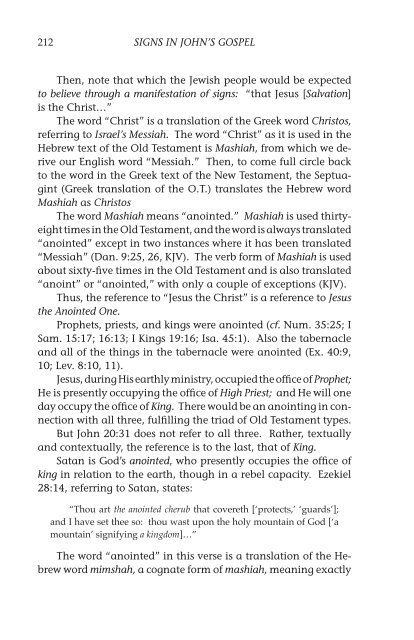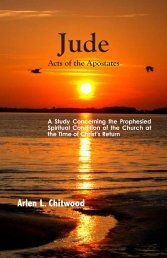Signs in John's Gospel - The Lamp Broadcast
Signs in John's Gospel - The Lamp Broadcast
Signs in John's Gospel - The Lamp Broadcast
You also want an ePaper? Increase the reach of your titles
YUMPU automatically turns print PDFs into web optimized ePapers that Google loves.
212 SIGNS IN JOHN’S GOSPEL<br />
<strong>The</strong>n, note that which the Jewish people would be expected<br />
to believe through a manifestation of signs: “that Jesus [Salvation]<br />
is the Christ…”<br />
<strong>The</strong> word “Christ” is a translation of the Greek word Christos,<br />
referr<strong>in</strong>g to Israel’s Messiah. <strong>The</strong> word “Christ” as it is used <strong>in</strong> the<br />
Hebrew text of the Old Testament is Mashiah, from which we derive<br />
our English word “Messiah.” <strong>The</strong>n, to come full circle back<br />
to the word <strong>in</strong> the Greek text of the New Testament, the Septuag<strong>in</strong>t<br />
(Greek translation of the O.T.) translates the Hebrew word<br />
Mashiah as Christos<br />
<strong>The</strong> word Mashiah means “ano<strong>in</strong>ted.” Mashiah is used thirtyeight<br />
times <strong>in</strong> the Old Testament, and the word is always translated<br />
“ano<strong>in</strong>ted” except <strong>in</strong> two <strong>in</strong>stances where it has been translated<br />
“Messiah” (Dan. 9:25, 26, KJV). <strong>The</strong> verb form of Mashiah is used<br />
about sixty-five times <strong>in</strong> the Old Testament and is also translated<br />
“ano<strong>in</strong>t” or “ano<strong>in</strong>ted,” with only a couple of exceptions (KJV).<br />
Thus, the reference to “Jesus the Christ” is a reference to Jesus<br />
the Ano<strong>in</strong>ted One.<br />
Prophets, priests, and k<strong>in</strong>gs were ano<strong>in</strong>ted (cf. Num. 35:25; I<br />
Sam. 15:17; 16:13; I K<strong>in</strong>gs 19:16; Isa. 45:1). Also the tabernacle<br />
and all of the th<strong>in</strong>gs <strong>in</strong> the tabernacle were ano<strong>in</strong>ted (Ex. 40:9,<br />
10; Lev. 8:10, 11).<br />
Jesus, dur<strong>in</strong>g His earthly m<strong>in</strong>istry, occupied the office of Prophet;<br />
He is presently occupy<strong>in</strong>g the office of High Priest; and He will one<br />
day occupy the office of K<strong>in</strong>g. <strong>The</strong>re would be an ano<strong>in</strong>t<strong>in</strong>g <strong>in</strong> connection<br />
with all three, fulfill<strong>in</strong>g the triad of Old Testament types.<br />
But John 20:31 does not refer to all three. Rather, textually<br />
and contextually, the reference is to the last, that of K<strong>in</strong>g.<br />
Satan is God’s ano<strong>in</strong>ted, who presently occupies the office of<br />
k<strong>in</strong>g <strong>in</strong> relation to the earth, though <strong>in</strong> a rebel capacity. Ezekiel<br />
28:14, referr<strong>in</strong>g to Satan, states:<br />
“Thou art the ano<strong>in</strong>ted cherub that covereth [‘protects,’ ‘guards’];<br />
and I have set thee so: thou wast upon the holy mounta<strong>in</strong> of God [‘a<br />
mounta<strong>in</strong>’ signify<strong>in</strong>g a k<strong>in</strong>gdom]…”<br />
<strong>The</strong> word “ano<strong>in</strong>ted” <strong>in</strong> this verse is a translation of the Hebrew<br />
word mimshah, a cognate form of mashiah, mean<strong>in</strong>g exactly



